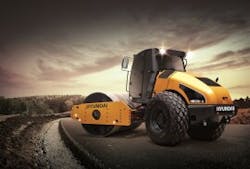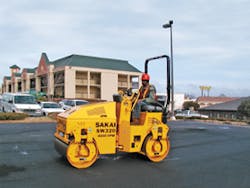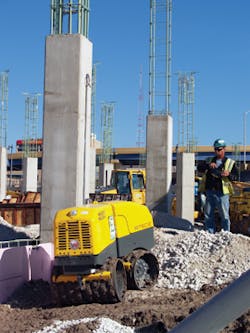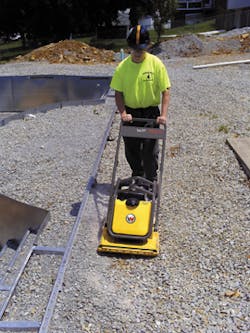Selection of the correct equipment depends on many factors, ranging from soil type to spatial allotment to other specific needs unique to each application. Matching the correct compaction tool to the job increases efficiency by optimizing production, minimizing costs, and enhancing profitability.
The act of soil compaction consists of the removal of air pockets from the material-soil or rock-by applied force, resulting in a denser base that has the ability to hold more weight on a level surface. Soil compaction on a construction site also serves as an act of preventive maintenance, because it eliminates settling, cracking, or heaving of driveways, sidewalks, floors, foundations, and walls.
Selection of the correct equipment depends on many factors, ranging from soil type to spatial allotment to other specific needs unique to each application. Matching the correct compaction tool to the job increases efficiency by optimizing production, minimizing costs, and enhancing profitability. The act of soil compaction consists of the removal of air pockets from the material-soil or rock-by applied force, resulting in a denser base that has the ability to hold more weight on a level surface. Soil compaction on a construction site also serves as an act of preventive maintenance, because it eliminates settling, cracking, or heaving of driveways, sidewalks, floors, foundations, and walls. [text_ad] Getting the combination of soil type and site parameters matched to the type of compactor can be complicated. Three of the most common types of compactors are the plate compactor, the "jumping jack," and the road roller. Plate compactors typically have a large vibrating base plate to create a level grade. They work well on sand, gravel, and other granular soils with large, coarse particles, because instead of relying exclusively on pressure for compaction, the vibration allows the particles to separate and fall freely under their own weight into a stable position. In general, vibratory plates are more efficient than rollers because their large base-plate surface area comes in contact with more material. They're also more maneuverable, making them ideal in confined spaces. Single-direction plates work well with sand and gravel in small spaces; they're also suited for asphalt patching and edging along curbs and around fixtures. While pneumatic compactors are typically used on granular or mixed soils, they are rarely used on cohesive soils. Instead, a vibratory rammer or sheepsfoot roller works better on silt, clay, or other cohesive soils with fine grains that clump or become sticky when wet and are difficult to crumble when dry. The impact force causes a shearing effect that squeezes out the air and excess water. The rammer should be used on cohesive soils in narrow areas (4 inches to 24 inches wide) or adjacent to structures, while the trench or sheepsfoot roller is better in larger trenches and open areas. [caption id="attachment_60703" align="alignleft" width="270"]Getting the combination of soil type and site parameters matched to the type of compactor can be complicated. Three of the most common types of compactors are the plate compactor, the “jumping jack,” and the road roller.
Plate compactors typically have a large vibrating base plate to create a level grade. They work well on sand, gravel, and other granular soils with large, coarse particles, because instead of relying exclusively on pressure for compaction, the vibration allows the particles to separate and fall freely under their own weight into a stable position. In general, vibratory plates are more efficient than rollers because their large base-plate surface area comes in contact with more material. They’re also more maneuverable, making them ideal in confined spaces. Single-direction plates work well with sand and gravel in small spaces; they’re also suited for asphalt patching and edging along curbs and around fixtures.
While pneumatic compactors are typically used on granular or mixed soils, they are rarely used on cohesive soils. Instead, a vibratory rammer or sheepsfoot roller works better on silt, clay, or other cohesive soils with fine grains that clump or become sticky when wet and are difficult to crumble when dry. The impact force causes a shearing effect that squeezes out the air and excess water. The rammer should be used on cohesive soils in narrow areas (4 inches to 24 inches wide) or adjacent to structures, while the trench or sheepsfoot roller is better in larger trenches and
open areas.
The SW320 vibratory asphalt roller from Sakai
Jumping jacks have a smaller foot and are often used to compact backfill in narrow trenches for utility work. Smooth-drum and ride-on rollers are generally used for compacting crushed rock or asphalt for a base layer underneath foundations, parking lots, sidewalks, or driveways. They have an advantage in larger, open areas where there is room to maneuver. Because of their faster travel speed, they can cover a big expanse faster than a plate, making them beneficial in road construction.
Rollin’ the Road
Road construction is a major priority for Rodney Ness. As Burleigh County highway superintendent, he’s in charge of maintaining 1,550 miles of roadway, mostly rural, in North Dakota’s second-largest county by population, spanning 1,600 square miles. “It’s about 85% rural prairie up here,” he estimates. “Our focus is road maintenance and construction. We do a lot of gravel road maintenance.”
To assist with that, Ness supervises a crew of 26 full-time, year-round maintenance staff, with an additional 10 temporary workers in the summer for road repair. “We lay a lot of gravel.”
To get the job done, he relies on 11 motor graders and seven Walk ‘n’ Roll packer/rollers from LyCox Enterprises Inc. His most recent purchase was the WR75 Series 3 Walk ‘n’ Roll packer/roller about a year ago. The unit is 75 inches wide, has ten 7.50-by-15-inch 14-ply tires and five individual walking beams, which are the heart of the machine. Individual walking beams prevent rollover of voids in the surface and assure complete compaction.
“We buy superior products if we have the flexibility. We can spend up to $50,000 on equipment before it goes to a bidding process,” Ness explains. “We looked at them all: LyCox has the best
The Wacker Neuson RT 82 features an infrared remote-control system.
features.” The most impressive feature he noted was ease of use. It attaches to the machine with detachable pneumatic rollers. “With the Walk ‘n’ Roll quick-tach system, all it takes is two pins and a couple of minutes.”
Another feature of the Walk ‘n’ Roll attached compactor that attracted him is its compaction effort. “The others have rigid-mount axles,’ he explains, “but the Walk ‘n’ Roll has a bogie wheel that follows the contour of the road for uniform compaction, better quality.” Because it’s used primarily for compacting gravel roadbeds over rolling prairie, that is a critical asset.
His crew can use it during the day, but can also easily drop it and pick it up later if they want. “They just back up, “˜quick-tach’ to the rippers and go,” Ness sums up. Neither does it take a lot of manpower to use. “With the old pull-type, you need power to pull. We use a motor grader, so there’s no need for an extra machine or man.”
Also important is ease of maintenance. To gain access for maintenance, Ness says the crews oscillate the bogie in the down position and pull the line. “With a rigid, you have to drop the entire axle. It’s labor-intensive. This is quick and easy.” Routine maintenance is also easy, he adds, because all that’s necessary is daily greasing of the bogie oscillating assembly and wheels. With that minimal care, he anticipates a long life. “It will last forever. There’s no engine power train or transmission-just a frame assembly with wheels. I don’t see it ever wearing out.”
Luckily for Ness, the Lycox compactor is durable, because he says the Burleigh County Highway Department has several projects lined up. “We have the money to work with on several good-size projects. Bismark hasn’t felt the recession much; economic development hasn’t slowed a lot. We need to build perimeter roads and collector routes and other roads need to be upgraded. We even added four full-time positions.”
After a winter that was “slightly above normal” and in anticipation of a tough spring with accompanying flooding issues, crews will be busy repairing seasonal damage to the roads…with a little help from their Walk “˜n’ Roll. Ness claims that multiple counties in North Dakota are running “many of these units. They caught on fast in the road maintenance industry. They’re built for this.”
Because compaction has a large component associated with excavation work it merits close attention, says Dale Asplund, vice president of business services for equipment rental leader United Rentals. “Historically, demand for excavation and compaction equipment is a leading indicator of a positive turn in construction activity. We’re seeing the early signs of that now.”That positive news follows more than a year of lesser demand that has been “particularly hard on the large rollers,” says Asplund. “Contractors typically rent the bigger units to ‘top off’ their owned fleet when they take on simultaneous projects. When job activity slows down, the larger end of the rental range for compaction feels it first.”
By contrast, many contractors have continued to rent the smaller machines throughout the downturn, says Asplund, who points to “trench rollers, walk-behinds and below” as the range least subject to economic pressure. “The math works in favor of renting smaller compaction equipment because the time and expense of transporting them can’t be justified, given the low cost of renting. Sometimes that dynamic shifts as you move up through the range, depending on the contractor’s ability to house, maintain and transport the larger machines.”
Asplund notes that as contractors search for work farther afield, “transportation becomes more of an issue. The location of a job can affect a contractor’s profit margin in ways that weren’t on the radar when every site was local.”
Provided by United Rentals
Drum Roll, Please
Some are built better than others. Of all the selection criteria, reliability was the one factor that caused Mike Moore, president of Moore Contracting in Pocola, OK, to switch brands. After enduring numerous breakdowns with his old compactors, he took a second look at Sakai. “Our local dealer is Sakai. Since we weren’t happy with the rollers we had, decided to try them.”
He’s glad he did. Moore purchased two Sakai SW330 vibratory asphalt rollers. “I liked the first one so much, I bought a second one recently. They’re unbeatable.” He also got a Sakai vibratory roller. Reliable and easy to operate and maintain, they are efficient and productive. “The number of passes is reduced,” he says. Reducing the number of passes necessary for compaction increases productivity. The number of passes required to reach the targeted density is part of the productivity equation, along with coverage width of the drum, lift thickness, average compaction speed during operation and efficiency of the application.
Part of that equation includes the Sakai’s well-thought-out watering system, Moore believes. Although it’s a slightly smaller truck that holds a little less water than some of its competitors, he says the adjustable system allows for more hours of service, which again increases productivity.
Efficiency is the name of the productivity game. Thanks to its compact size, the SW330 can be loaded with a paver and transported on the same load. In addition, it doesn’t wear out the equipment or the operators. “The drums vibrate for compacting, but we don’t get a lot of vibration to the operator.”
Having previously passed Sakai over because he thought the styling was outdated, he discovered benefits to the design he formerly disliked. “It provides excellent visibility on both sides,” Moore says. He praises the comfort of the bench seat, which is not only ergonomic, but also allows operators to slide from side to side for better viewing-a feature that comes in handy when his crew is working on a parking lot, subdivision, a commercial site or even doing street overlay.
In business for 15 years and specializing in asphalt work, Moore says it’s a competitive market. It’s so competitive that he doesn’t expect business to increase. “It’s similar to last year; I don’t expect it to grow.” Business has been consistent, but could soon increase. “We’ve been lucky: there’s a lot of overlay work right now.” He credits a wet and cold year with creating potholes and a need for asphalt work.
Water Works
Jim Schier doesn’t own vibrating rollers; he leases them when needed. “No bigger stuff,” says the head of Schier Construction Co. Inc. in Houston, TX. Instead, his inventory includes six jumping jacks and eight to 10 plate compactors from Wacker Neuson Corp., because “water work is done in small, confined places-inside a circular concrete ring wall with a 20-foot diameter where you couldn’t even move a roller.”
The Bobcat S185 SSL vibratory roller
When Schier started his company 30 years ago, he started with water plant work. “We did water tower work for five general contractors who build water towers. We do the foundation and site work, put in a gravel access road; they build and paint the tower. Then we come back to do the piping, fencing, and roads.” Typical contracts range from $15,000 to $1 million.
As his company grew, he expanded to include construction of water distribution plants in the Houston area. That work includes the well, piping, tanks, controls, and all the electrical work, with one project budgeted at $4 million.
“We still do water towers all over Texas, Louisiana, Oklahoma, and some of Arkansas. We also design-build metal buildings and do some work for the Catholic church-parking lots, et cetera.”
The diversity in jobs is matched by the variety of soil types his crews have to work with. “We have all kinds of soil in Texas,” Schier, a civil engineer, details. “Houston is flat with sandy clay soil; Austin has solid rock limestone; Dallas has sticky gumbo stuff; and Galveston is sandy. We use a drum roller for banked sand material, but we use a sheepsfoot roller in Austin because the feet on a roller wouldn’t work in sandy material.”
In addition to the compaction equipment Schier owns, he has an additional 40 pieces of Wacker equipment, including generators, eight to 10 chop saws, water pumps, and vibrators for concrete work.
“I’ve had a relationship with Wacker for 20 years,” says the onetime Wacker Contractor-of-the-Year finalist. The relationship was built on quality equipment and service, he says. “Maintenance is number one. We have a full-time mechanic on staff to do most routine stuff, but these are high-maintenance pieces of equipment. Wacker has a local company to do service and maintenance.” The availability of parts played a part in his decision as well. “We have to keep the stuff rolling. We can’t wait on parts.”
Self-Propelled Soil Compaction
Wacker Neuson emphasizes the importance of selecting the right compaction equipment for the job by reviewing soil type, compaction specifications and job-site conditions. Along with the type of
Wacker Neuson’s WP 1550 A Vibroplate
soil being compacted, the method of compaction used is largely determined by the job specifications that need to be met. The most common compaction specifications include lift, or soil depth/layers, and the number of passes made with the machine to achieve optimum compaction. The right machine should have enough power to compact the soil in the depth required. Too little power will result in not reaching the proper density; too much can result in over compaction from excessive passes or too much power on too thin a soil layer.
One of the things Dave Varacalli, construction foreman for Meade Electric in Chicago, appreciates about his all-Wacker fleet is its ability to do “a good job of compacting in a couple of passes.” Varacalli oversees one of the company’s 25 underground crews, working with local utility companies, often in the heart of the windy city. In addition to underground utility work, he says, “We do just about everything-but not much grading.” Equipment on the job site can include excavators, cranes, track hoes, tampers and, of course, compactors.
Meade owns about 100 Wacker self-propelled, walk-behind, plate tampers with two handles for forward and backward operation. Varacalli has about 50 of them in his department alone. He likes the smaller Wacker compactor because, as part of utility installation, his crew often has to work near roads where ditch width is as narrow as 2 feet. “We excavate, then backfill with sand,” he explains, adding that “one guy can pick it up and maneuver [with it]. Other machines are bigger, not so easy to use.”
Because of its “compact” size, it’s easily portable. Varacalli’s crews can carry it in the front bucket of a combo machine. “In urban areas and especially high traffic areas, it’s an easy-to-use compactor.”
They used to use “ram-rodders-jumping jacks,” he says, but he prefers the Wacker tampers, especially when they lay the concrete road base after they’re done installing utility lines, which they leave high when hand- or machine-grading, because it “settles when tamping,” he explains.
Another feature he likes is its durability. “It’s rugged,” Varacalli says. “It takes a beating.” Proclaiming that “Wacker is one of the best,” he praises the quality and ease of maintenance. “Checking the oil is all the maintenance it takes.”
Minimal routine maintenance requirements will help Varacalli keep up with the busy schedule he expects this year. One of Meade’s clients is People’s Energy, a gas utility in downtown Chicago. Crews have been busy installing newer lines in older areas, focusing on low- and medium-pressure systems. Due to pressure from the Illinois Commerce Commission, which oversees public utilities, they typically upgrade more than just one building on the block. “We’re doing about 100 miles of main replacement per year. The budget for that work is $13 million in 2010, but it’s going to grow to $140 million in 2011.” Predicting more work on the horizon, he says he already uses his compactor “almost every day-at least every other day” and expects that pattern to continue.
Maintenance Routines
Not all contractors use their compactors daily, however. Bob Reed, project manager for Mix Brothers Tank Services in Norco, LA, says he doesn’t use his plate packer from Bobcat much, but when he needs it, he says, it works. In fact, he admits, “We leave it sitting in the weeds, and it starts right up!”
Mix Brothers does “tank jacking,” Reed says. “We used to do house jacking, until we got into the industrial side.” The company levels, lifts, and relocates fuel tanks as big as 100 to 200 feet across. One job involved a 117-foot diameter, 850,000-pound tank that had sunk into the Mississippi River at New Orleans. Lodged in the mud, its manways were half-covered and the roof joint was torn apart in two spots. The crew supported the floor with an engineered bracing system and lifted the whole tank out of the quagmire. Next, they installed a sub-foundation with a subsurface drainage system, a reinforced concrete ring wall and elevated granular pad. The crew then lowered the tank onto the new foundation after the safety cribbing was removed.
To safely lift and level fuel tanks, Reed says, they make a base, packing rock and sand with a Bobcat compactor attached to a track-hoe. Easy to haul, it’s also maintenance-free. “We haven’t touched it in four or five years.”
Maintenance intervals are typically that long. The equipment Doc Neeske uses has shorter-than-average maintenance intervals due to conditions. Neeske, owner of Neeske Custom Excavating in Colorado Springs, does residential and commercial structural excavating and site prep. He deals with every kind of soil within a 50-mile radius of his headquarters, he says. “It’s sandy in eastern part of the county, then it graduates, as you get near the foothills, to bedrock, clay stones, and sandy gravel.” He needs durable, reliable equipment that’s flexible and usable for all soil conditions, even though he realizes he “can’t do it all with one machine.”
Neeske does it all with several machines, including an Ingersoll walk-behind, ride-on rollers and smooth-drum rollers from Cat, shaker heads for a Cat backhoe, and jumping jacks. But it’s his Bobcat shaker head for his mini-excavator that he relies on to backfill in tight spaces. “The backfill zone on a foundation is a 5-foot zone,” he explains, “so we use the mini-excavator to start, because of its mobility and maneuverability. We attach shaker heads, because their capacity is matched to the machine well.”
It’s a simple, quick attach and detach, he adds, which is particularly important in a tight market because it speeds up the job so he can get to the next one. “There’s a lot of construction going on, but there are too many contractors for the work available. There’s a 300% to 400% difference in the number of bidders; we used to have five, now there are 20 coming from out of the city, out of the state-everywhere. The margins are low. We have to bid low-sometimes we have to bid at a loss to get work.” Having efficient, reliable equipment has helped him get enough work to “keep going” and increase efficiency on each job so he can maximize profitability.
Selling Features
“The economy is affecting things,” acknowledges Phil Bahler, one of the four partners in Bahler Brothers Construction, Hartford, CT. He estimates that business is down 35%-40%, but says they’ve made adjustments, such as offering promotions on Weber compactors in their online store. “It’s a good time to buy,” says the man who admits his glass is always half full.
Bahler Brothers took on Weber as a line to sell because they were so pleased with the products’ performance in the field, where they perform high-end residential work that includes using interlocking concrete pavers to build retaining walls, walkways, and patios.
“They’re well built,” Bahler says of the compactors. “In fact, they were one of the first ones built. They’re durable-reliable. They rarely have a problem.” He credits the choice of a Honda or Subaru motor with their dependability and adds that although “the smaller the motor, the more the maintenance, if you stick to the schedule,” there are few problems.
While Bahler carries several machines, he says popular models include the Weber CR 3, CF4 and SRV 620-the jumping jack. “We have three [jumping jacks],” he notes. “We use them all the time for tight spots and corners.” He says the rammers “hammer down deep” and work well on local soils-gravel, sand and clay. However, since the rammer draws up the moisture in the clay, in those conditions he says it’s better to use plates and amend the soil with straight stone. In other conditions, he says the filter system is well built, helping to combat dust on projects in sandy soil.
“They have a lot of neat features,” Bahler contends. One feature he likes is Compactrol, available on the CR7, the largest unit. “It tells you when you’re up to proper compaction.” He also likes the fact that the new Jumping Jacks can run partial throttle. “They don’t throw you all over in tight spaces. You don’t get out of control.
“They’re making compactors better all the time,” he sums up. That’s good, because Bahler has more work lined up this year than they did last year at this time and he foresees an economic upswing. Until then, he advises: don’t cut back on maintenance because it’s even more important in this economy, and buy the best equipment. “Do your homework. Compaction is everything in this business.”












